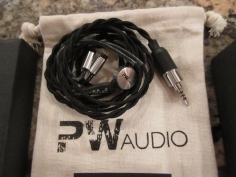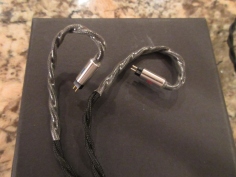Let’s Party like it’s… 1960!!!
PROS: a unique design with isolated different gauge pure copper wires, provides a naturally transparent and resolving fine-tuning of the sound, expands the soundstage.
CONS: price, not a very flashy design.
The product was provided to me free of charge for the review purpose in exchange for my honest opinion.
Manufacturer website: PWaudio, for sale on MusicTeck and Music Sanctuary.
Preamble.
Aftermarket premium replacement cables have been a controversial topic of discussions in many audio communities. There are some who don’t hear a sound improvement and others who consider the improvement to be too subtle to justify the cost. Some are firm believers (myself including) and do hear the change in sound, while others talk themselves into believing to validate their purchase. I also ran into a group of people who consider cables as another accessory to personalize the appearance, just like if they would with CIEM customization, or those who switch from single ended to balanced and take the opportunity to upgrade to fancier wires. And then you have a group who never tried a replacement cable and formed their opinion based on reading someone else’s rant.
From my personal experience, I do hear and feel the change in a sound, but I’m not able to capture it accurately in measurements. The most obvious change even disbelievers can agree on is that higher purity material will yield a smaller resistivity, better conductivity, and corresponding boost in signal level. Also, various metals have different properties. There is no magic behind it and you’ll get an instant benefit of a slightly boosted output, improving the efficiency of your headphones, something that could be measured. But when I hear a change in bass tightness or articulation, or I hear more airiness in treble or overall improvement in retrieval of details which feels like a layer of veil is lifted off – this is not easy to capture in measurement. Considering we all have a different perception of sound, without supporting measurements some people jump into conclusion and form a “snake oil” opinion, especially when price is taken into consideration.
The intent of this review is not to change anybody’s mind, but rather to share with you what I hear and how I hear it. Perhaps, I can’t fully explain why there is a change in sound, but I do hear it and would like to describe it. What makes sense to me is that I look at the wire as a material with physical properties of resistivity, conductivity, level of purity, etc, which acts as a filter between your source and headphones. Variations of these physical properties will affect the electric signal and result in a sound change, from a subtle to a more noticeable level. Also, I want to mention the design of these cables, to make people aware why they cost so much, and that you are not dealing with a “coat hanger” wire but rather high grade materials, advanced production techniques, and hours of labor which all add up to a premium cost. Finally, the sound improvement of one specific cable is not universal because it will depend on the synergy between your source and your headphones.
Intro.
Many of you probably noticed that lately I have been pushing the envelope of price limits as I continue my journey into the land of exotic flagship IEMs and cables. While sometimes it’s not easy to judge the price vs value of IEMs because of the diminishing return factor, it was a lot easier for me to set a reasonable limit for reviewing cables. I’m not just saying this, but have rejected in the past requests to review $1k+ cables. I figured that relative to IEM price any cable beyond $500 will be a stretch. But recently my mind was changed after talking to Calvin, the man behind a well-known Music Sanctuary audio shop in Singapore. His store has everything from many popular flagship C/IEMs to majority of well-known cables, as well as DAPs, DACs, accessories, and even DIY parts. But more than anything, Calvin is very passionate about cables, and he asked me if I would be interested to take a listen to PWA latest flagship Blackicon 1960s release. There was no hidden agenda since I wasn’t forced to review it, and certainly Music Sanctuary is not the only exclusive seller of PWA cables, though I should give Calvin a credit for spreading the word about this brand.
I don’t know too much about PWaudio except that it was founded in 2010 by Peter Wong (thus PW initials in the name), and they have a very impressive selection of premium wire cables in different price brackets. I’m looking today into their pricier flagship Blackicon model, they still have many other cables at a fraction of the price but not necessary a fraction of the performance. For example, their budget pure copper No5 (PWA 5th anniversary special edition cable) goes for about $150 and still has a great pair up synergy with many IEMs. Just remember, when it comes to diminishing returns you will end up paying a premium to get a lesser increment in performance.
So, I decided to have an open mind when I received for testing their 1960 2 wire (4-conductor) and 1960 4 wire (8-conductor) models. All I cared about was how these cables will improve the sound of selected C/IEMs in comparison to their stock and other aftermarket cables. This review is my subjective opinion, describing how I hear the sound, and hopefully the Preamble gave you an idea of where I stand regarding cables. So, if you still with me, let’s get to it!
Unboxing and accessories.
Unboxing experience of 1960s cables was a bit underwhelming. Both cables arrived in individual small black cardboard boxes with a distinct PWA label which had a faded “PW” and a regular “audio” print. Inside there was a cotton storage bag, and nothing else. The cable was terminated with 2.5mm Balanced connector, and I didn’t need 3.5mm Single Ended adapter, though I do recommend to order one as an accessory. I have seen PWA adapters in pictures, and they look pretty sturdy. If you start with 2.5mm BAL, you can always convert it to 3.5mm BAL, 4.4mm BAL, or just 3.5mm SE.
Not sure if that was just because I received a review sample, but for a premium product it would be nice to have a cool leather storage case or one of those leather organizer bands with a snap button. This will distinguish between their budget and premium cable models, where for example, No5 packaging was the same.
2-wire unboxing:
4-wire unboxing:
Design.
When it comes to 1960-2w/4w you have a choice of 11 different cable terminations and 9 different connector types. My review unit arrived with universal 2pin connectors, having a premium metal outer housing with clearly labeled R (Right side in red) and L (Left side in blue) and a gold-plated Tellurium copper connector. The protruding plastic part of the connector accommodates recessed 2pin sockets without a problem. The cable termination side had a premium Furutech FT-7254, 2.5mm connector. This one is the top of the crop which has a hybrid pin constructed with rhodium-plated Alpha hybrid copper and a special audio grade P.P. Resin insulation. The housing of the connector was stainless steel, and on top had a rubbery heat shrink to enhance the grip.
For those who think every cable connector is created equally, it’s not. Many don’t realize that connector is part of the audio signal path, and depending on a material and even a solder selection, you could have some subtle changes affecting the sound. Furthermore, 2.5mm connector is thin to begin with, so having a sturdy construction is very important when connecting directly to a DAP or an adapter. During my recent testing of DX200, I went through a dozen of different DAPs, constantly plugging and unplugging the cable, and the solid construction of FT-7254 never let me down. Cable termination and connectors is under your control when you customizing the cable. If you already going for a flagship, don’t skimp out on the component section.
Many people associate the price of the cable with a cost of the material, where many are OK to pay a premium knowing you are buying pure silver or gold plated silver or a hybrid with different exotic materials. Blackicon 1960s uses a pure OCC Copper Litz wires, sourced directly from US. I have no idea what is so special about these specific pure Copper Litz wires and why you would pay premium to source the material from US, but it’s not only the wires but also a unique ergonomic form factor of the cable design.
Apparently, the cable uses 26AWG wires and FEP jacket for a positive signal and 24AWG thick wires and PVC jacket for a negative signal. The wires are insulated and combined under a tightly braided sleeving which has a very nice touch and feel. Don’t expect a see-through jacket which exposes every string of the wire. This cable is not about looking pretty, and as a matter of fact from a distance it could resemble a thin appliance power cord. I’m telling you up front, if you are looking for a replacement cable based on its looks and can’t hear a sound difference, better stick to PWA No5 pure copper cable with its see-through copper shine. Blackicon is about sound performance. Btw, the cable is hand braided and built by Peter Wong himself, which adds to a waiting time since it’s built to order.
Since positive and negative signal wires are combined under the same sleeve, you can only see Left and Right wires but underneath you have 4 separate conductors. Going from 2-wire to 4-wire design, you double the number of wires with 8 separate conductors, and slightly increase the weight of the cable (from 28g to 40g). The y-splitter is a basic heat shrink with PWA branded logo, while a choker (chin-slider) could be chosen as either metal or wooden. The 1960-2w (2-wire) arrived with a metal one, which I found to be a bit slippery, and I had to apply a little mod with a wire wrap underneath to keep it from sliding down. 1960-4w (4-wire) had a wooden choker with enough friction to have some resistance when adjusting it, and I recommend it over the metal one. Also, the earhook portion of the cable has a pre-shaped clear sleeve which I found to be very comfortable and secure, and was happy not to deal with a memory wire.
2-wire design:
4-wire design:
2-wire vs 4-wire design comparison:
The fit (Zeus XRA w/1960-2w):
































would you recommend this cable for the xelento? or is there another cable you prefer?
LikeLike
Hard to tell because most of the cables I have are 2pin, while Xelento is mmcx. Another thing to keep in mind, Xelento doesn’t work with every standard mmcx connector cable. I’m personally ok with their stock cable.
LikeLike
Great, comprehensive review. Too bad you couldn’t get the PW Limited to talk about. That’s the one I’m thinking of going with for my CL2 and Sony 1A.
LikeLike
Didn’t even know one existed.
LikeLike
Thanks for the review. Would the 1960 2-wire pair well with a Tia Trió ?
LikeLike
Sure, and 2wire version will pair better than 4wire in this case.
LikeLike